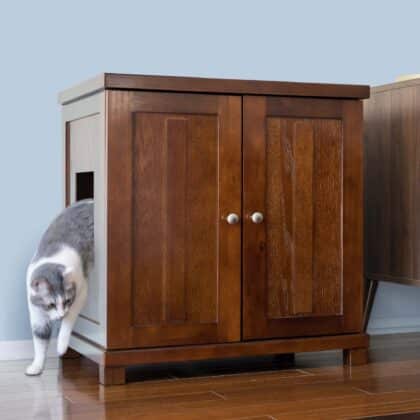
Let’s Talk About Fleas
It’s an unpleasant topic to talk about, but something that cat owners need to be aware of: Fleas. These pesky little bugs are most prevalent during the summer months but can live any time of year. Even if you think your region isn’t prone to them, most pet owners deal with fleas at some point so it’s good to be knowledgeable. Here’s the rundown about fleas, their causes, and treatment options from The Refined Feline.
What Are Fleas?
There are many types of fleas, but we will concentrate on the most common kind: dog and cat fleas. They can jump from cats and dogs to other mammals, but are most commonly found in these two species. Fleas are tiny insects that survive by feeding on blood, whether it’s an animal or a human. They have four stages of life: eggs, larva, pupa, and then adulthood. Depending on the climate and what’s around them, fleas can live anywhere from a few months up to a whole year. They thrive in high humidity and warm temperatures, around 70-85 degrees.
How To Know If Your Cat Has Fleas
Check Your Cat For Flea Dirt
If you’re wondering whether there are fleas in your home, there are a few ways you can check. These bugs mostly stay on your pets, so check them regularly. Spread their fur until you can see their skin and check for any tiny black dots. If you see little black dots, that is flea dirt which is the excrement left behind by the fleas. Fleas are slightly egg-shaped and very small, but you can see them with the naked eye. You can also use a flea comb, which can help you check for flea dirt more easily.
Watch For Excess Scratching or Irritated Skin
Another indicator of fleas in your home is if your cat is scratching a lot or experiencing hair loss. Flea bites tend to be very itchy and irritating to your cat’s skin. So, cats will scratch frequently as they can have quite a few fleas on them at a time. If your cat is allergic to flea bites, their skin will become very inflamed. It’s important to check your cat’s skin for any irritation, redness, bumps, or hair loss, especially around the tail. They may bite their skin in an effort for relief as well, which has the potential to lead to skin infections.
Check Yourself For Little Red Bite Marks
If you find fleas or flea dirt on your pets, chances are they’ve made it all around your house. The eggs can easily transfer to you, other animals in your home, or surfaces like their cat towers or trees. You may notice some small red bug bites around your ankles or lower legs. Even if you don’t feel fleas biting you, they can still be using you as a taxi back to your cats. However, adult fleas can’t survive long if they aren’t on a mammal. If they can’t find the skin to bite they usually won’t live past 24 hours. If you do start to notice little red bumps on your skin though, it could be a sign that there are fleas in your home.
Keep An Eye On The Litter Box
Fleas can transfer tapeworms to your cat if they ingest the adults containing tapeworm eggs. The easiest way to determine if your cat has tapeworms is by checking the litter box and looking for tapeworm segments, which look like grains of white rice, attached to their stools. Your cat may also experience irregular stools or weight loss. If the fleas are prevalent enough in your home, your cat may eventually become anemic. If there are enough fleas on your pet, they could potentially cause a large loss of red blood cells. So, it’s important to get fleas taken care of in a timely manner.
Related: How To Give Your Cat A Home Health Check
How To Get Rid of Fleas On Cats
Make sure to thoroughly clean your home after giving your pets their first dose of flea medication. It usually takes about 24 hours to get rid of all remaining fleas and eggs. You should vacuum regularly and keep floors clean of debris. If you have a yard, keep the grass short and trimmed regularly, as well as any shrubs or bushes.
Depending on the level of infestation, you may need to use a carpet spray or a specific flea killer. Thoroughly clean your home again in 3-4 weeks to ensure you’re eliminating fleas in their egg stage as well. You may even need the assistance of a flea fogger to eliminate them. Remove your pets before using any flea fogger in your home though! Continue to check your pets regularly to ensure the fleas are gone.
Tips For Preventing Fleas On Cats
The best way to get rid of and prevent fleas in your home is through flea medication. However, you must ensure that the flea preventative you purchase is for the right species. Flea medications for dogs are toxic and dangerous when given to cats. You should only use cat-specific flea preventatives for your furry felines. The majority of these medications work against all life cycles of fleas, and will usually work against ticks too. If you aren’t sure where to start, it’s always best to check with your vet.
Keep Your Home And Cat Free of Fleas
Keeping a close eye on your pets will help keep your home protected from these tiny terrors. Even if your area doesn’t typically have fleas, it’s still a good idea to check your pets and home regularly. They may be around, but not causing your cat as much irritation to the point that you notice them. If these troublesome insects do find a way into your home though, don’t worry! Make sure to give your pets the proper flea medications to help get them treated, then tackle your home.










